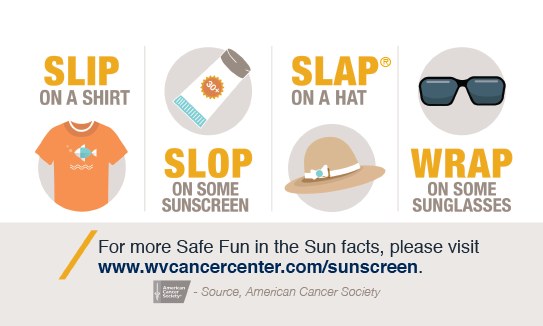After an odd mixture of weather this winter and spring, summer is fast approaching as we turn our attention to protecting ourselves from the dangerous rays of the sun.
Clothing choices play an important role in protecting our skin as it acts as a sunscreen. A long sleeved top and brimmed hat may be helpful to protect exposed skin during peak sun hours. However, sunscreen is very necessary, even with the right clothing choices, in keeping your skin healthy during all seasons, especially from the intense rays of the summer sun.
What is sunscreen?
Sunscreen filters out the sun’s dangerous UV (ultraviolet) rays. These invisible rays can cause skin cancer. Some skin cancers can cause death if not found and treated early.
What are common mistakes?
- People use too little sunscreen—you should apply liberally and use at least one ounce or a shot glass size full for one application for the average sized person.
- People use a sunscreen with a low SPF number—you should use at least an SPF of 15, although an SPF of 30 is recommended.
- People use sunscreen once for all day sun protection—you should follow the directions on your sunscreen bottle for the time recommended between applications.
- People get sun exposure between 11 am – 3 pm—you should actually limit your sun exposure during this time of day as the sun’s rays tend to be more intense.
- People think because it is cloudy they do not receive any harmful rays—you should be even more mindful on cloudy days as the sun’s rays are just as dangerous.
- People think a tan make us look healthy—you should know that a tan comes from the cells of skin damage.
Who should wear sunscreen?
People of all skin colors can get skin cancer from the sun’s UV rays. Some medications can make the skin more prone to sunburns. Ask your healthcare professional if your medications or anything specific to you puts you at greater risk for sunburn or skin damage. Children need extra attention to avoid sunburns as this can increase the risk of skin cancer in later years. Those who are most likely to get skin cancer from these rays have:
- Lighter natural skin color.
- Skin that burns, freckles, gets red easily, or becomes painful from the sun.
- Blond or red hair.
- Blue or green eyes.
- A family member who has had skin cancer.
Also, people who spend a lot of time outdoors, either for work or play, are more likely to get skin cancer from UV rays.
Which sunscreen should I use?
Use a sunscreen with a Sun Protection Factor (SPF) of 15 or higher (although SPF 30 is recommended). Sunscreens come in many forms, including ointments, creams, gels, lotions, wax sticks, and sprays. Follow the directions on the package for using a sunscreen product on babies less than 6 months old. All products do not have the same ingredients; if your or your child’s skin reacts badly to one product, try another one or call a doctor.
When do I need to apply sunscreen?
The sun’s UV rays can damage your skin in as little as 15 minutes. Put sunscreen on before you go outside, even on slightly cloudy or cool days. Don’t forget to put a thick layer on all parts of exposed skin. Get help for hard-to-reach places like your back.
Sunscreen wears off. Put it on again if you stay out in the sun for more than 2 hours, and after you swim or do things that make you sweat.
- Apply sunscreen approximately 30 minutes before being in the sun (for best results) so that it can be absorbed by the skin and less likely to wash off when you perspire.
- Remember to reapply sunscreen after swimming or strenuous exercise.
- Apply sunscreen often throughout the day if you work outdoors, and wear hats and protective clothing.
How to Apply Sunscreen
The American Cancer Society has a catchy approach to Safe Sun Practices:


Slip on a shirt, Slop on some sunscreen, Slap on a hat, and Wrap on some sunglasses. You will also want to do the following:
- Shake well your sunscreen bottle before use to mix particles that might be clumped up in the container. Consider using the new spray-on or stick types of sunscreen.
- Be sure to apply enough sunscreen. As a rule of thumb, use an ounce (a handful) to cover your entire body. One ounce is equivalent to the size of a full shot glass for a single application on an average sized person.
- Use on all parts of your skin exposed to the sun, including the ears, back, shoulders, and the back of the knees and legs.
- Apply thickly and thoroughly.
- Be careful when applying sunscreen around the eyes.
What to Look for When You Buy Sunscreen
- Pick a broad-spectrum sunscreen that protects against UV-A and UV-B rays and has a sun protection factor (SPF) of at least 15, but SPF 30 is recommended..
- Buy a non-stinging product or one specifically formulated for your face.
- Buy a brand that does not contain para-aminobenzoic acid (PABA) if you are sensitive to that ingredient.
- Try a sunscreen with different chemicals if your skin reacts badly to the one that you are using. Not all sunscreens have the same ingredients.
- Use a water-based sunscreen if you have oily skin or are prone to acne.
- Be aware that more expensive does not mean better. Although a costly brand might feel or smell better, it is not necessarily more effective than a cheaper product.
- Be aware of the expiration date because some sunscreen ingredients might degrade over time.
Please note, the information provided throughout this site is not intended or implied to be a substitute for professional medical advice, diagnosis or treatment. All content, including text, graphics, images, and video, on or available through this website is for general information purposes only. If you are experiencing related symptoms, please visit your doctor or call 9-1-1 in an emergency.

